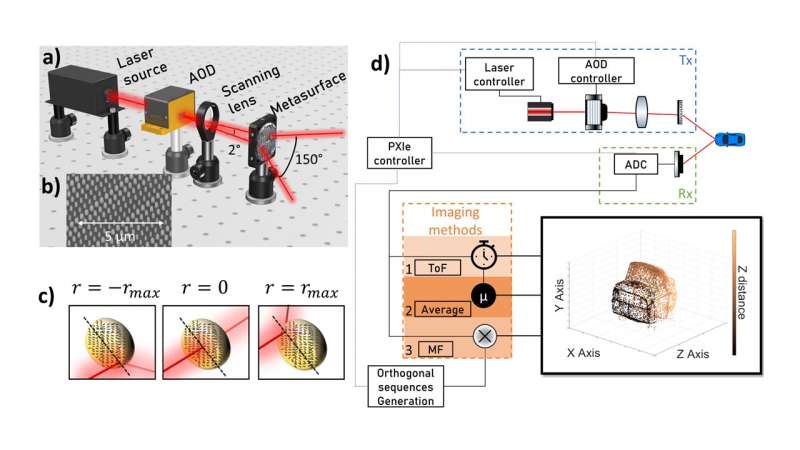This article has been reviewed according to Science X's editorial process and policies. Editors have highlighted the following attributes while ensuring the content's credibility:
fact-checked
trusted source
proofread
Wide field-of-view metasurface-enhanced scanning lidar may hold promise for autonomous vehicle technology

Pulsed laser scanning lidar is a core technology for autonomous driving and robotic mobility. Herein, a directional light pulse is backscattered by a reflective object and the elapsed time between emission and detection of the pulse is used to calculate depth. These direct time-of-flight (d-ToF) measurements of returning light pulses enable the three-dimensional imaging of complex scenes.
At present, lidar technology requires numerous developments, including enhancement of the observation field of view (FoV) with high angular resolution, improvement of the imaging frame rate, extension of the ambiguity range by reducing the signal-to-noise ratio (SNR), and reduction of fabrication costs and component size, for its large-scale industrial application in the global market.
Patrice Genevet's group at Université Côte d'Azur in France has proposed an innovative solution to address some of the limitations of lidar technology and meet the demanding requirements of automotive lidar. Their work is available in Advanced Photonics.
The researchers present the experimental prototype of an ultra-fast high FoV pulsed metasurface-scanning lidar. It uses a laser diode modulated by an acousto-optic deflector (AOD) and cascades it with a metasurface, enhancing the FoV up to 150° in both horizontal and vertical directions. Additionally, the metasurface's optical properties are continuously varied to expand the narrow FoV of the deflector. Lastly, the detection part of the system employs a highly sensitive photodetector digitized by an analog to digital converter.
Pulse scanning lidar, though working on a simple physical principle, typically suffers from low SNR and poor accuracy for objects located far away within the ambiguity range, i.e., the maximum measurable distance. Also, there is a tradeoff between the ambiguity range and speed inherent to d-ToF imaging. Recognizing these issues, the researchers propose a novel imaging technique that softens the above-mentioned trade-off in pulse scanning lidar.
Inspired by the code division multiple access (CDMA) pulse encoding method—a multiplexing illumination technique traditionally used in telecommunication theory—the imaging process takes advantage of the high scanning speed of the AOD without compromising on the ambiguity range or the simplicity of the architecture. This technique enables imaging in low SNR environments.
Experimental results demonstrated that the block CDMA technique extends the ambiguity range of the lidar by up to 35 times—to kilometer distances—compared with the traditional single pulse lidar. It also enhances the SNR of the lidar images, enabling better performance in noisy environments or at longer distances.
The researchers highlight that the new scanning lidar system, leveraging the capabilities of metasurfaces, nearly meets the requirements for automotive lidar and holds promise for novel applications. It is compact and has the potential to be scaled down to chip-scale dimensions. This miniaturization will open new possibilities and exciting prospects for autonomous vehicles and robotic industries.
The research provides a solid framework for the next generation of high-speed lidar, offering insights into new capabilities and opening the doors to more novel cutting-edge technologies. The scientific advance improves prospects for smoother autonomous driving and adaptive robots.
More information: Emil Marinov et al, Overcoming the limitations of 3D sensors with wide field of view metasurface-enhanced scanning lidar, Advanced Photonics (2023). DOI: 10.1117/1.AP.5.4.046005
Provided by SPIE




















